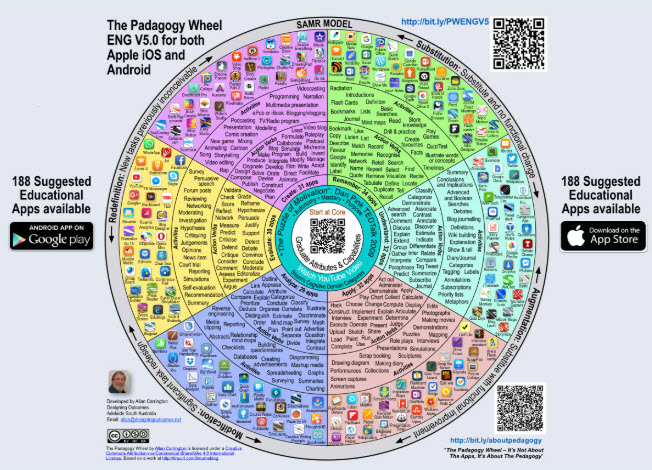
“There’s an app for that” ™ is a statement that is so common that Apple trademarked it. As consumers and instructors we all know that there are so many different mobile device applications or apps available to us through online stores. If you want to measure pollution in your location, download the Plume app. Do you want to talk to a friend? Use FaceTime. Order takeout? Just launch the Skip the Dishes app. Some of us have been trying out different language learning apps for the purpose of language teaching. Many of us use apps designed for purposes other than language learning with our students to foster learning. If you think about it, you may have used Whatsapp to communicate with your students or Tinkercad to create real objects or Haikudeck to make a class presentation. There are so many apps available it is difficult to determine if you are making an informed choice when choosing an app for your lessons.
The Padagogy Wheel was designed to help educators consider how mobile apps can be used by their students. It also guides instructors to a cluster of possible tools that align with instructional requirements. The Padagogy Wheel encourages instructors to begin with a course outcome, ask themselves questions based on that outcome, and arrive at app options for their consideration.
The Process
1. Identify the desired outcome
In your course documentation, identify which outcome you are undertaking.
2. Match outcome with one of Bloom’s Revised Digital Technology Cognitive Domains. Andrew Churches’ Bloom’s Updated-Digital Technology Taxonomy includes new learning opportunities offered by emerging technologies.
Are the student going to be:
- memorizing (remembering) information?
- trying to understand meaning of information?
- applying the information construct or demonstration?
- analyzing information to deduce conclusions?
- evaluating information to consider an issue?
- creating with information to publish a project?
3. Choose one or two terms from the Action Verbs sector that matches the Bloom’s cognitive domain term.
4. Select an activity type from the Activity sector.
5. Consider the apps in the corresponding sector. Then choose one to generate a learning opportunity for your lesson.
6. Identify how the app will be used as a learning tool in terms of the SAMR model. Does it simply substitute normal classroom learning activities? Does your new app driven learning event
After creating the activity and implementing it with your class, take time to reflect on the learning event. If it was a success, make alterations to the activity based on your observation notes that you made during and immediately after the lesson. Consider sharing this activity with your instructional peers to elicit their feedback. Since your students are already familiar with the app, it may be used in different course units or in different ways moving forward through the school year.
Example
Last year, I used Kahoot as a means of reinforcing course vocabulary and nudging more vocabulary on a unit-by-unit basis. I followed these Padagogy steps towards identifying and creating a lesson for the students.
- Identified the course outcome, use / practice vocabulary and vocabulary building strategies in listening, speaking, reading, and writing contexts.
- The Bloom’s outcome was identified as create, as I was hoping to ensure students generated a product that enhanced their use of new vocabulary.
- Actions verbs collaborate and construct were chosen. As students would work in pairs and the ultimate goal was to create a product using unit vocabulary.
- To incorporate fun and challenge, new game was chosen in the activities sector.
- After considering a few apps, I decided to use Kahoot as the tool to create a digital game.
- This activity could easily be accessed and played by classmates; it redefined their learning as they collaboratively created an original activity that was accessible globally.
I hope the Padagogy Wheel is useful for those who are working towards blending technology into their instruction. It provides teachers with a system rather than randomly selecting an app. Thanks to Allan Carrington for designing this useful model.
If you use it in planning an activity, share your experience below.
Resources
Carrington, Allan. https://designingoutcomes.com/assets/PadWheelV5/PW_ENG_V5.0_Apple_iOS_PRINT.pdf
https://designingoutcomes.com/assets/PadWheelV5/PW_ENG_V5.0_Android_PRINT.pdf
Churches, Andrew. Bloom’s Digital Taxonomy. http://www.pdst.ie/sites/default/files/BloomDigitalTaxonomy-AndrewChurches.pdf
Designing Outcomes, source of the Padagogy Wheel, https://designingoutcomes.com
Haikudeck, https://www.haikudeck.com
Whatsapp, https://www.whatsapp.com
Tinkercad, https://www.tinkercad.com

One thought on “Choosing an App for your Lessons with the Padagogy Wheel”
Comments are closed.